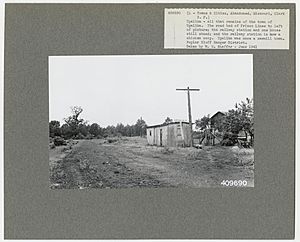Upalika, Missouri facts for kids
Upalika was once a small town in the state of Missouri, in the United States. Today, it is known as an "extinct town" or a ghost town. This means that no one lives there anymore, and the buildings have likely disappeared or fallen apart. It was a community that grew up around a railroad line.
Contents
What Was Upalika?
Upalika was a small community located in the southwestern part of Wayne County, Missouri. It was once a lively spot, but over time, people moved away, and the town faded. Places like Upalika are important because they tell us about the history of how towns grew and sometimes disappeared.
Where Was Upalika Located?
Upalika was situated on County Road 426. It was about five miles southwest of a town called Williamsville. It was also about 5.5 miles east of Ellsinore, which is in a nearby county called Carter County. This area is in the southern part of Missouri.
How Did Upalika Begin?
Upalika started around the year 1891. This was when a railroad line was built and extended to that exact spot. Railroads were very important back then. They helped transport goods and people, and new towns often grew up along their routes. Upalika was one of these towns.
The Post Office
A post office was opened in Upalika in 1892. This was a big deal for the community. A post office meant that people could send and receive letters and packages. It also showed that the town was growing and had enough people to need its own mail service. The Upalika post office stayed open for many years, finally closing in 1927. After the post office closed, it was a sign that the town was shrinking.
What Does the Name "Upalika" Mean?
The origin of the name "Upalika" is a bit of a mystery! Some people believe the name comes from a Native American language. This would mean it has roots in the history of the land's first inhabitants. Others have a different idea. They think that a worker on the railroad, who helped build the line through the area, named the town after his wife. Both stories are interesting ways to think about how places get their names.


